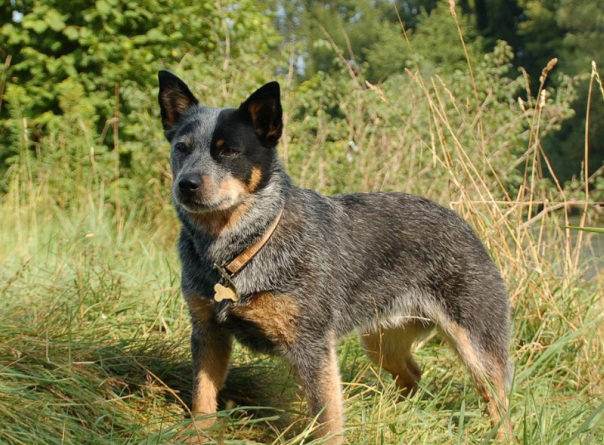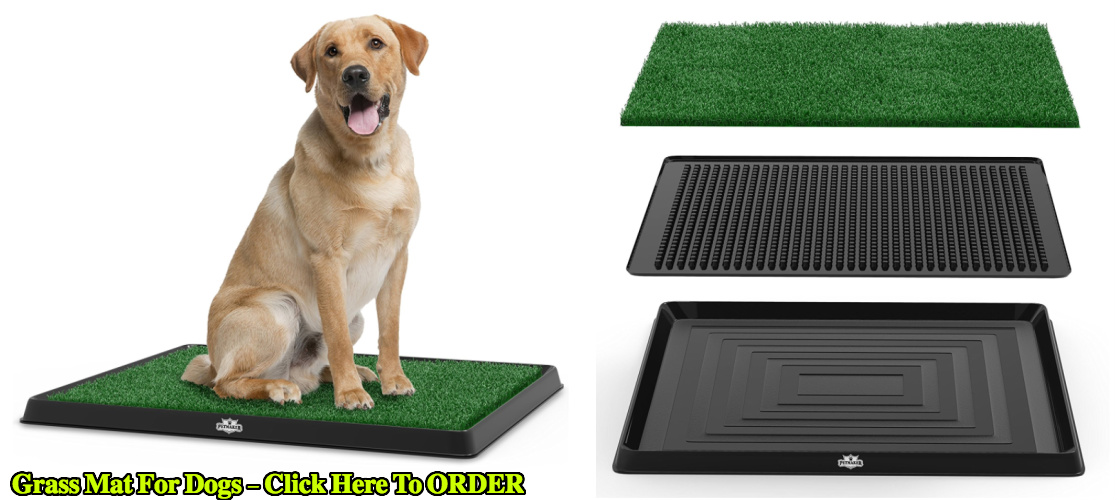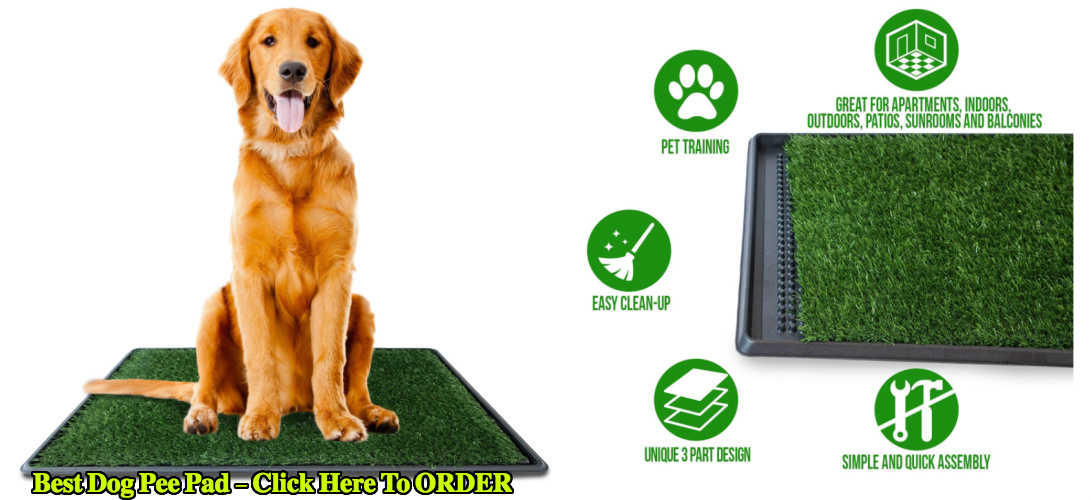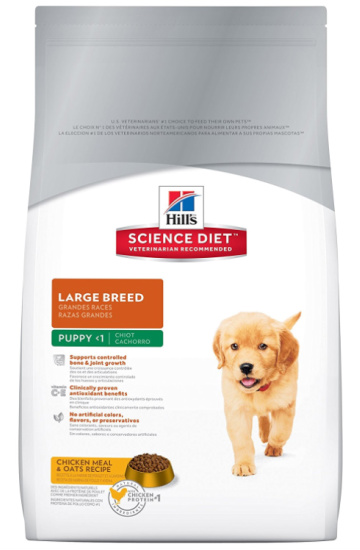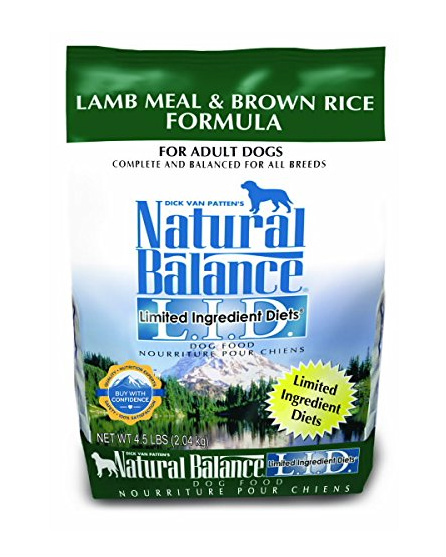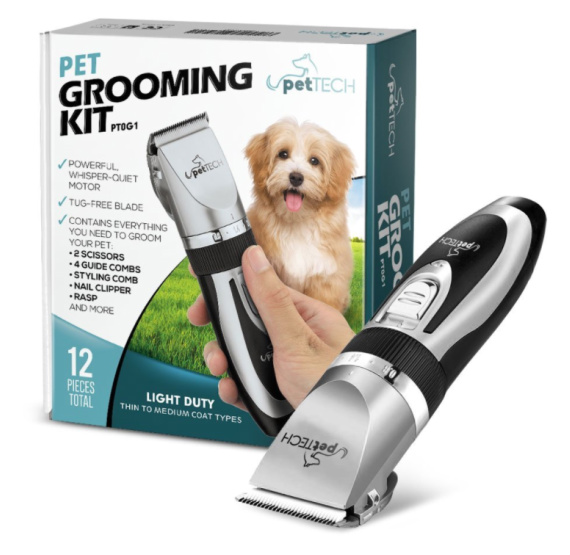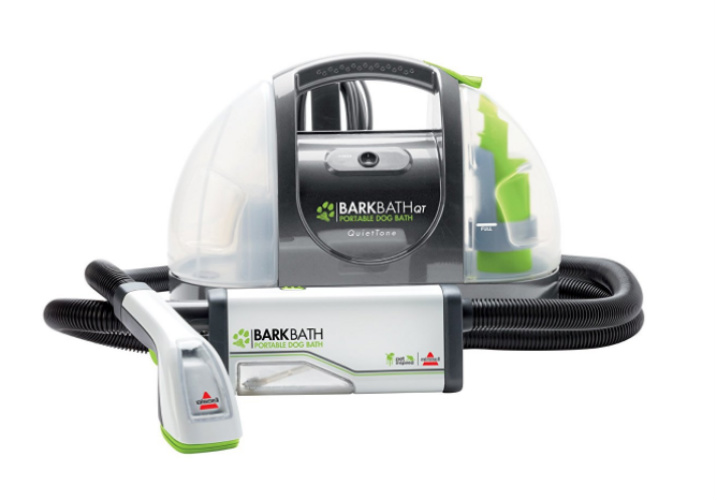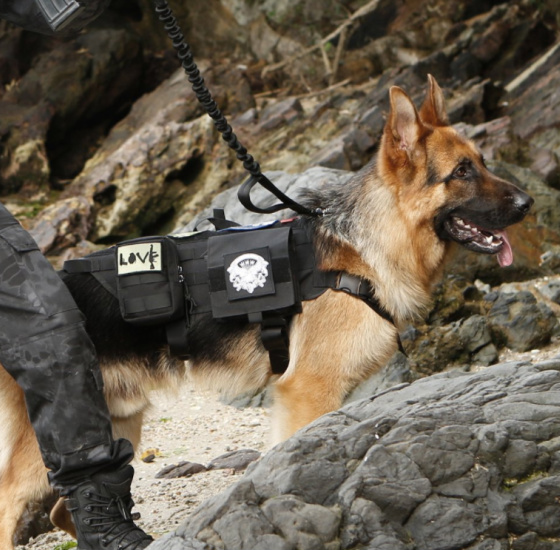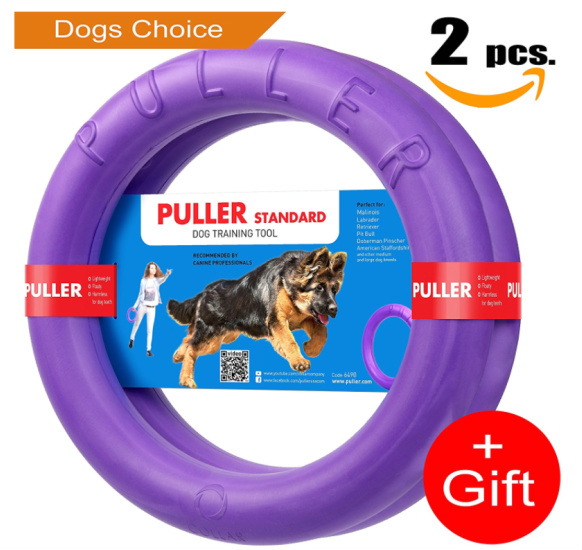Blue Heeler Dog Breed Temperament Diet And Training
Table Of Contents
- 1 1. Introduction To The Blue Heeler
- 2 2. What is the Blue Heeler?
- 3 3. Blue Heeler History
- 4 4. Blue Heeler appearance
- 5 5. Famous Blue Heelers
- 6 6. The Characteristics of the Blue Heeler
- 7 7. Choosing a Blue Heeler Puppy
- 8 8. House Training Your Blue Heeler
- 9 9. Blue Heeler Nutrition
- 10 10. Grooming the Blue Heeler
- 11 11. Fun Facts About Blue Heelers
- 12 12. Breeding a Blue Heeler: Choosing the Right Breeder
- 13 13. Obedience training for Blue Heelers
- 14 14. Dealing with your Blue Heeler’s annoying Behavior
- 15 15. Blue Heeler Health
- 16 16. Travelling with your Blue Heeler
- 17 16. Games to Play With Your Blue Heeler
1. Introduction To The Blue Heeler
If your favourite colour is blue, the Australian Cattle Dog (ACD) or Blue Heeler is the dog for you.
This hardworking, unassuming fellow is an ideal companion for any dog owner. It stands out because of its blue appearance and resilience.
We present to you a complete guide on the Blue Heeler and share a few anecdotes about this cheery, handsome fellow.
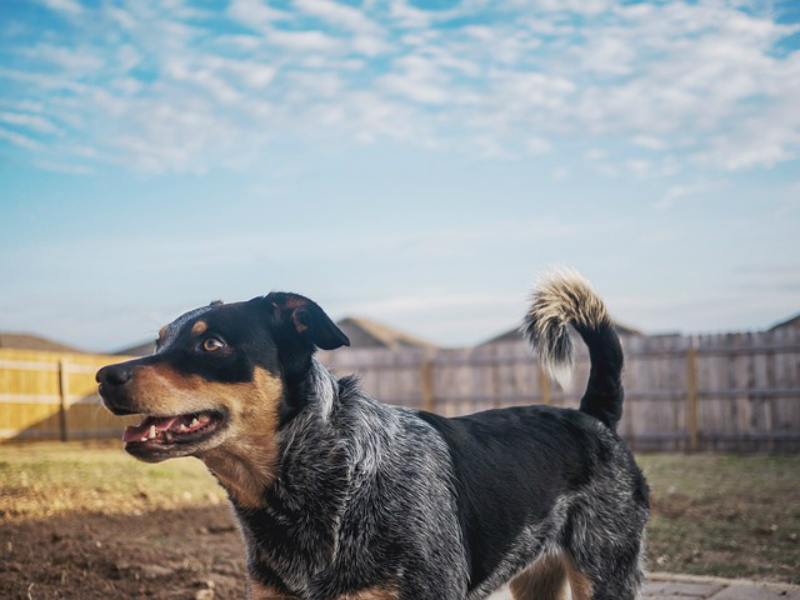
2. What is the Blue Heeler?
The Blue Heeler is a cattle dog that Australian breeders developed to herd livestock. Hence, it has another name, the ‘Australian Cattle Dog.’
The Blue Heeler is a medium-sized dog with a short coat. It has brown or black hair mixed with a white undercoat. Hence, it has a ‘blue’ appearance.
3. Blue Heeler History
a. The Blue Heeler’s beginning
The Blue Heeler began with Australian cattle rancher George Hall, who arrived in New South Wales in 1802. He had started expanding into Liverpool Plains and Queensland. Hall wanted to solve the problem of cattle becoming lost as they moved over rugged terrain.
Ranchers needed a dog to herd cattle. Unfortunately, the only ones that were available were Old English Sheepdog type dogs that only herded cattle over small distances.

So, Hall mixed dingos with drovers. He developed a new dog which he called the Halls Heeler. Because the Halls were the only ones who used Halls Heelers, they gained an advantage over other cattle ranchers.
b. The Blue Heelers Spread
The Blue Heeler caught the attention of the Cattle Dog Club of Sydney, which consisted of men whose pastime was showing dogs. They used the name Australian Cattle Dog to describe dogs that came from the Halls Heeler line.
One of the Halls associates, Robert Kaleski, created a standard for the breed. Breeders all over Queensland adopted it. His writings gave insight into the early history of the Blue Heeler. He believed that red heelers were more aggressive than blue ones. Kaleski also thought that Dalmatian and Kelpie infusion explained the Blue Heeler’s mottled hair. Kelpie lineage was unlikely because the Blue Heeler developed before it. Also, coat colours made Dalmatian lineage unlikely.
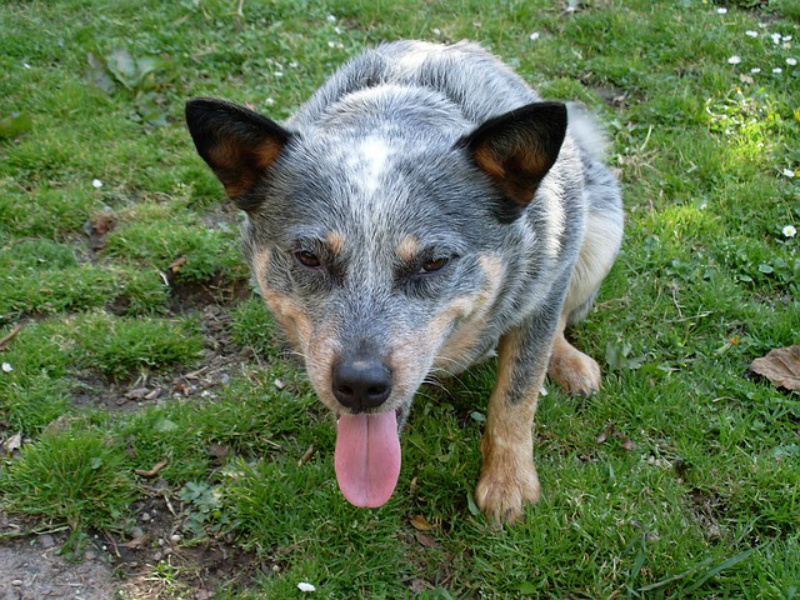
Breeders showed Australian Cattle Dogs all over Queensland throughout the 1890s. Little Logic was the first Blue Heeler to appear at dog shows in Sydney. By the 1950s, dogs that were descendants of Little Logic became popular. This new breed earned the name Queensland Heeler.
c. The Blue Heeler in the United States
An Australian veterinarian named Allen McNiven introduce Kelpies, dingoes, German Shepherds, and Kangaroo hounds into his breeding program. The Royal Agricultural Society Kennel Club refused to acknowledge these dogs. McNiven gave them papers from deceased dogs, but the RASKC stripped him of his membership when they discovered this. He continued to ship his improved dogs to the United States. Greg Lougher, a cattle rancher from Napa in California, took a liking to the dogs and imported them.
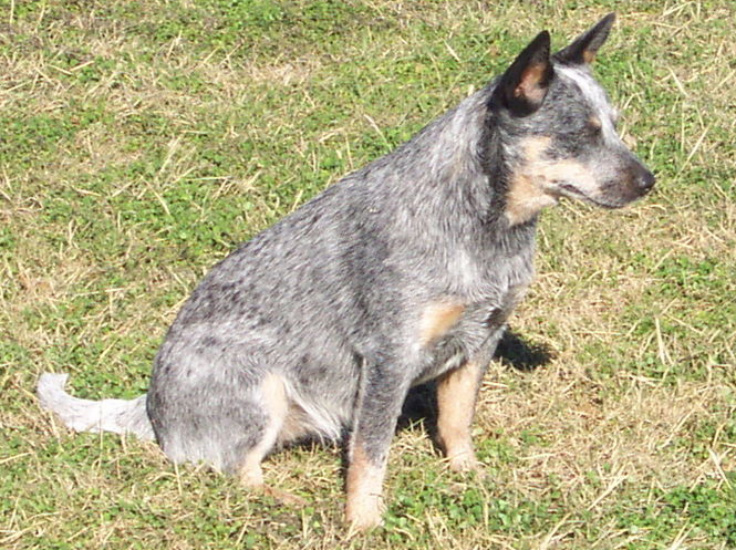
Doing so proved to be wise on his part. Jack Woolsey, a veterinarian in Santa Rosa, liked Lougher’s dogs. He began to breed them himself. Other breeders jumped on the bandwagon and advertised these dogs as Queensland Heelers. The National Society of Butler, Indiana, acknowledged the breed.
Blue Heelers appeared in American Kennel Club dog shows, but only in the miscellaneous category. The club had refused to give them full recognition because they had no Parent Breed club. Esther Ekman and Chris Smith -Risk formed one in 1967. After extensive research, many breeders in their club discovered that some of their dogs had Australian Cattle Dog lineage. The National Society of Indiana continued to register them.
d. The Blue Heeler in Canada
The Canadian Kennel Club registered the Blue Heeler in January 1980 after breeders and other enthusiasts had spent five long years going to win support for it. A small number of Blue Heelers worked in cattle ranches all over Canada. A little-known breed Club showed the dog at Obedience and Confirmation shows. Landmaster Carina became the first Blue Heeler to earn confirmation and obedience titles.
e. The Blue heeler in the United Kingdom
The first Blue Heelers arrived in the United Kingdom in 1980. They were two puppies named Lenthal Finton and Lental Darlot. Another dog, Landmaster Darling Red, was an outstanding female owned by John and Mary Holmes.
The blue heeler gene pool was still limited. Hence the Australian Cattle Dog Society formed and officially recognised the breed, although they put it in the ‘Unclassified category. It performed in obedience and working trials.
4. Blue Heeler appearance
The Blue Heeler is sturdy and compact. It has well- developed muscles that give it strength and agility. They explain the dog’s excellent performance in dog shows.
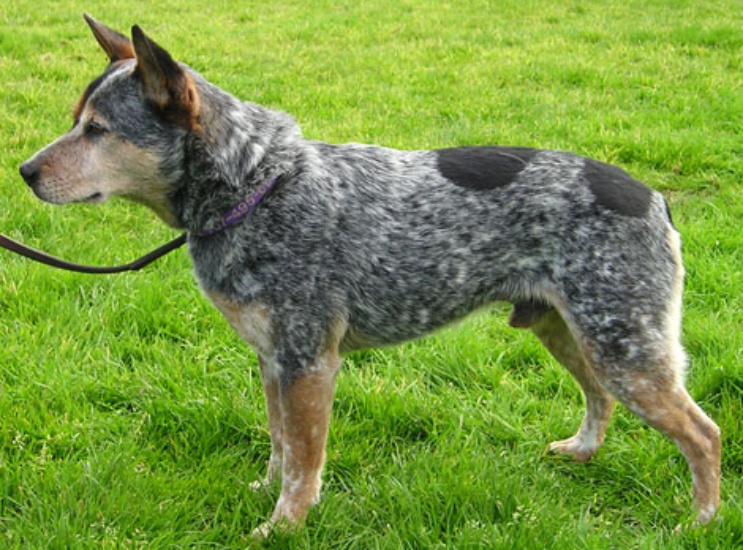
Its body should be longer than its tail. The ratio of its height to its tail should be about 9: 10. It has brown eyes and a broad skull.
The blue heeler has wide-set, small ears. They must stand upright when the dog is paying attention to you. It has a medium sized muzzle and a slightly curved tail.
Male Blue Heelers are between 18 to 20 inches tall. Females are slightly smaller at between 17 to 19 inches.
The Blue Heeler has a double coat. Hair colours are either blue speckled or blue mottled. Puppies have no coat colour at birth. They develop markings as they grow.
5. Famous Blue Heelers
a. SkidBoot
Skidboot, a Blue Heeler owned by David Hartwig of Texas is deceased, but its incredible story isn’t. David still gets calls for him to perform the circus tricks the dog executed so flawlessly.
All David, a diligent Texas farmer wanted to do was to put in an honest day’s work for an honest day’s pay. What he expected is a trusty canine assistant, Skidboot, to merely help him out with the chores on his farm.
But he got more than he bargained for from his Australian Cattle Dog. David was about to give him away because his neighbours had complained about his mischief. But he formed an unbreakable connection with the dog.
David and his new sidekick began to perform at rodeos and circus shows. Skidboot’s Celebrity Dog status grew. David entered his Blue Heeler in the national competition, Pet Star. Skidboot wowed the judges and ‘pawed’ away with the top prize of $25000.
Skidboot’s victory led to an appearance on the Oprah Winfrey Show. The dog became accustomed to bright lights and limousines. And so did the humble farmer.
But David felt that it was his and Skidboot’s duty to bring joy to others, so they became regular guests at church gatherings and other events.
Skidboot eventually went blind and passed away in 2007, but the calls kept coming in. David gave in to the constant requests to have either Skidboot or his other pets perform. He was reluctant as his new dogs didn’t have Skidboot’s abilities, but he eventually caved because audiences convinced him that the effort was worth it.
His new dogs, Tiedown, Bois d’arc and Little Skidboot, continue to perform tricks as Skidboot Senior did.
Skidboot’s legacy continues.
b. Blue
A loyal Heeler, Blue, kept his three-year-old charge warm when she got lost.
The three -year -old, Victoria Bensch, wandered off from home on Thursday afternoon. Her parents were frantic.
Fortunately, a staff rancher from the Department of Public Safety spotted her and the family dog, Blue, about three-quarters of a mile from her home. His helicopter had supported her huddled with the dog, trying to keep herself warm.
Victoria was alright, though her parents were worried about frostbite. Authorities had airlifted her and her mother to the Phoenix Children’s Hospital. She had faced the cold in her T-shirt, pants and tennis shoes. The dog had stood between her and hypothermia.
Victoria’s searchers say that it was the dog that saved her life. Her father is grateful for their help.
6. The Characteristics of the Blue Heeler
The Blue Heeler may have a nipping tendency because of its herding style. Its ancestors bit the heels of cattle to move them.
It is bold and athletic. This dog loves nothing better than to rough-house with your kids. Do note that you should supervise both children and dog during play.
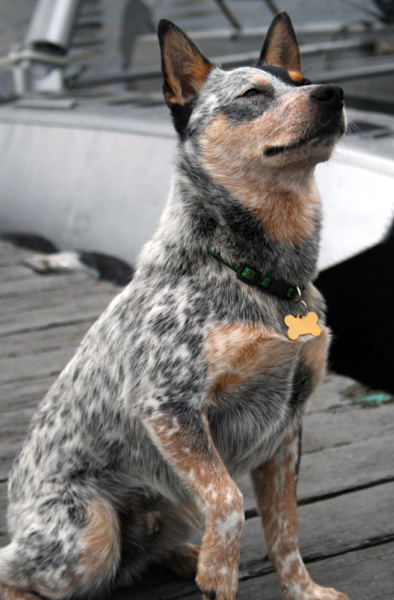
The Blue Heeler is an outdoor dog, without question. To stay well-built and alert, it requires plenty of physical stimulation. Take it on jogs or hikes. It enjoys chasing balls as well. Don’t leave it alone without anything to do because of it apt to develop destructive behaviours. As you know, it has a lot of energy and must have an outlet for it.
The Blue Heeler is a watchful fellow. It doesn’t react very well to strangers, so early socialisation is necessary.
The Australian Cattle Dog needs a firm hand. It can learn to do a great deal if it has an assertive owner.
A Blue Heeler will suit you if you like large sized dogs. Welcome it into your home if you want a rugged companion. Keep it if you don’t want to install an alarm because it makes an excellent watchdog.
Get this dog if you don’t have a lot of time to spend on grooming. It has a short, low-maintenance coat.
The Blue Heeler is rather strong-willed and may not always listen to you. Welcome it home if you appreciate a dog that has a mind of its own.
It may also be aggressive towards other people and pets. Bring it on daily walks or to dog runs where it can interact with other animals.
The Blue tends to chase anything that moves. Make sure that you keep it on a leash at all times when outdoors. Do read the section on how to control such behaviours.
The Blue Heeler has a propensity for barking, which can annoy you and your neighbours. What’s particularly irritating is that its voice is somewhat high pitched. Once more, do read the section on how to manage this behaviour.
Adopting an adult Blue Heeler may limit these behavioural problems. A previous owner may have trained it, so it may not show these negative characteristics.
If you have your heart set on a puppy, choose one from the correct breeder. We advise how to pick the right one in the section on breeding Blue Heelers.
7. Choosing a Blue Heeler Puppy
Your new blue heeler puppy will be a family member, so it makes sense to choose one that fits in with your lifestyle. Here are the points you should consider when picking one out.
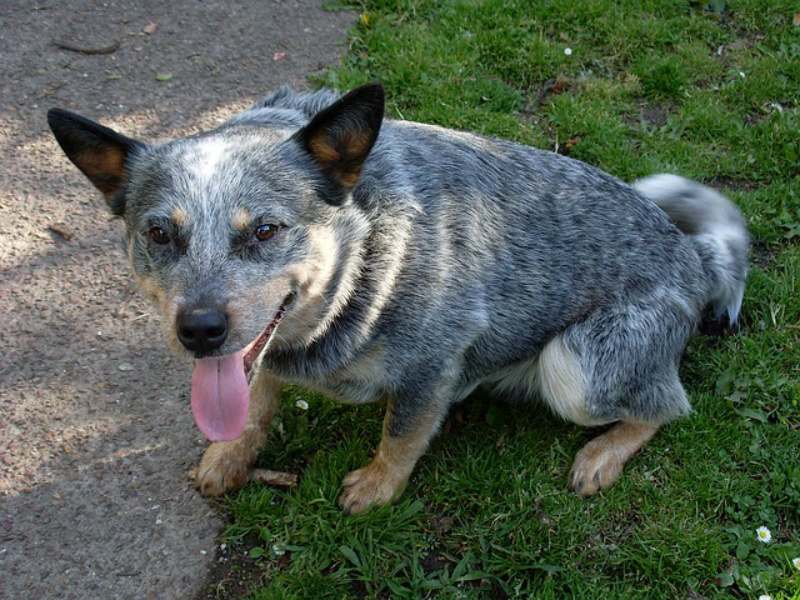
a. Understand the breed standard
First of all, find out how a pedigree blue heeler’s Conformation, or whether it matches the expected form of the breed. The information should help you choose a bona fide Blue Heeler puppy.
A Blue Heeler should have a slightly curved, broad skull. It should flatten to a slight, definite stop. The dog should have muscular cheeks, but they shouldn’t be too prominent.
The Blue Heeler has a broad face and is well-filled under the eyes. Its muzzle is medium-length and robust. The top line of the muzzle alights with the top edge of the skull.
This dog has white, evenly-spaced teeth that close in a scissors bite. It has oval-shaped, dark brown eyes that betray its intelligence and alertness. Yellow eyes are a fault. It should have a black nose.
The Australian Cattle Dog should have moderately-sized ears that are set apart on the skull. They should be firmly erect. The outer ear should be thick and the inner ear, hairy. It has a solid, muscular neck. The neck is of medium-length and broadens before blending into the rest of the body.
It has muscular, sloping shoulders that merge well with the upper arm. The shoulder blades should not be too close to the tips or too heavy, as they would hamper its working ability. Its forelegs are straight.
The body’s length, from the breastbone to the buttocks, is longer than the height at the withers. It has a level topline, a steady back, and well-sprung, moderately broad chest. The croup slopes slightly. Hindquarters are full and well-developed. The hind legs are parallel and not too far apart.
The Blue Heeler should have short, round, stable feet that are close together. It could have deer claws on the forelegs. It has a low-set tail that aligns with the slope of its croup. It hangs with a slight curve.
The Heeler has a weather resistant, short, flat coat. It’s longer under the body. There is slight breaching behind the thighs. Hairs are thicker and longer along the neck. The nose is short on the head, front of the legs and feet. It’s about 1 to 11/2 inches in length on average.
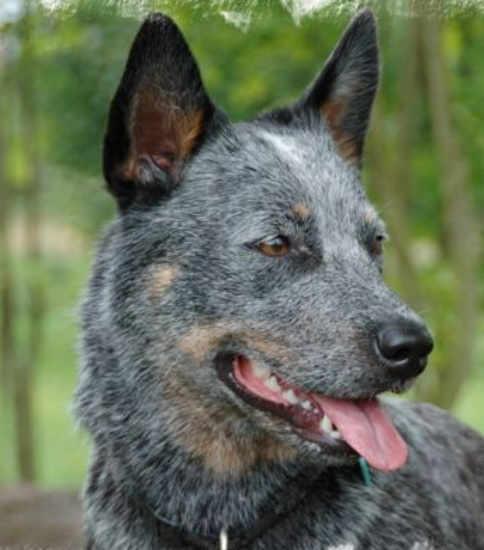
Coat colours are blue, blue-mottled, blue-speckled, red, red-mottled or red-speckled. There should not be black markings on its body. Red Heelers should have red hair distributed evenly all over their bodies, while Blue ones will have tan markings on their jaws.
Males should measure between 18 to 20 inches and females between 17 and 19 inches. The dog has a confident, tireless gait and should be able to move quickly.
b. Meet the parents
Observe the Heeler puppy’s parents. Do they have genetic disorders or hereditary illnesses? Do they have quirky personality traits? The puppies could have inherited these.
c. Observe the Blue Heeler puppies
Observe how the puppies interact as a litter. Look out for dominance issues. Dominant puppies would be the first to feed. Choose a puppy which suits your personality.
Then, observe them one by one. Cradle and lift the puppies. The more responsive a puppy is to handling, the better.
8. House Training Your Blue Heeler
Blue Heelers like Skidboot are quick learners, so house training them is not much trouble. Paper, crate, and outdoor training are essential for making sure that yours pees in the right places. We explain some of these procedures here. Your little Heeler will become an expert at the potty.

a. Setting a routine
Routine is the key to getting your Blue to pee and poo at the right times and places. Puppies usually need to ease themselves when they awake, after they eat, and before they sleep. Make sure that you take your Heeler puppy out during those times.
b. Outdoor training
When training your pet outdoors, it’s essential that you bring it to the same spot that it used before. It will be able to recognise it’s scent and ease itself.
c. Crate Training
You may raise your eyebrows at the idea of a crate because it means keeping the dog in a confined space. But it will keep your little Blue safe. It’s also useful when you want to take it on road trips.
The most significant challenge of crate training is to acclimatise your Blue to its ‘home’. To do this, put a treat it the crate. It may help to persuade your blue that it’s a safe place. Include its favourite cushions and toys. The dog will enter once it knows that the crate is comfortable.
d. Paper Training
You’d have to paper train your pet, especially if you don’t have a garden for it.
You can enclose it in a puppy playpen. Lay newspaper in it and leave it there. Your puppy will know that this is its toilet. Remove some paper as it becomes used to relieving itself in the area. Do this until only a small area remains. Your pet will know that it should ease itself only within this area.
e. Using Bells
Bells remind puppies that it’s potty time. Hang one over the doggy door or in front of your dog’s crate. Get your puppy to hit it with its paws when it’s time for it to go. It will soon associate the sound with potty time.
f. Potty Pads
If newspapers don’t work for you, try potty pads. The most significant advantage of these is that they are reusable. Wash them.
g. Recommended Potty Training Tools
You will be successful potty training your Blue Heeler if you use the right tools. Here are a few must-have recommendations.
i. Sonnyridge Potty Training Synthetic Grass
This potty trains your Heeler quickly because the surface is very similar to grass. You’ll find it helpful if you live in a condominium or apartment.
Its simple to clean. Rinse it, and it’s ready to use again. Because it consists of anti-microbial grass, bacteria cannot grow. It also absorbs foul smells.
This innovative product features a three-layer system. The outer layer is synthetic grass, while the middle layer is a tray that separates the upper and the bottom layers. The bottom layer is a tray that captures urine.
Puppies will love it immediately since it resembles grass. It is the perfect place for dogs to use when the weather is harsh. Note that the tray spills quite easily.
These bells tell your Blue that it’s time for a walk, some stretching and quick relief. The Potty Bells Housetraining package includes a 1.4-inch doorbell and potty training for puppies.
This tool makes it easier for your pet to communicate that it needs to go. It can ring bells instead of bark. Furthermore, the three-step training program is straightforward. Hang them and get your dog to hit them. It will connect the sound with potty time.
Also, these bells are extra loud. You won’t miss hearing them. Moreover, they include a lifetime guarantee.
Customers report that it only took their pets a little time to become accustomed to the sound and understand that they must use the bells to show their owners that it’s time to go. Note that they may rust.

This artificial grass patch is perfect for owners who have little time to potty-train their Blue Heelers. It’s also ideal if they live in apartments. It gives your pet a space to relieve itself indoors.
The 3-layer system makes cleaning up a breeze. All you have to do is rinse it with soapy water. The artificial grass is anti-microbial, so you won’t have to worry about bacteria or odours. If you’re wondering when your pet’s urine goes, there is a tray that holds it.
Customers say that this system works efficiently. Incredibly, some say that it got their pets to relieve themselves at the right spots within 24 hours. Do watch out for people who may have allergic reactions to fake grass.
iv. Ideas in Life Dog Potty Grass
This artificial grass patch is an efficient potty training system. It comes in sizes for big, small, and medium-sized dogs. It’s useful when you can’t take your Blue out because of the weather. Put it on your patio or balcony.
Cleaning this grass patch is effortless. The grass tray has holes for your pet’s urine to pass through. It’s also weatherproof, so you don’t need to worry about rain damaging it.
Since it’s weather resistant, so you won’t have to worry about leaving it outside. It is also safe because it’s non-toxic. Ideas in Life does not use harsh chemicals in its products.
Customers report that this incredible tool works quickly. They found it indispensable in situations when they could not take their pets outside. Dogs prefer it because it’s convenient.The only problem is that cleaning it can be a little messy. Putting potty training pads around it helps.
9. Blue Heeler Nutrition
If you are a parent of a Blue Heeler, you must commit yourself to a healthy lifestyle. Since it is a working dog, you can’t keep it sedentary for long.
We show you what ‘ human’ foods are safe for your Blue and offer a few diet tips. We also bring to you a few of the best dog foods for Blue Heelers.
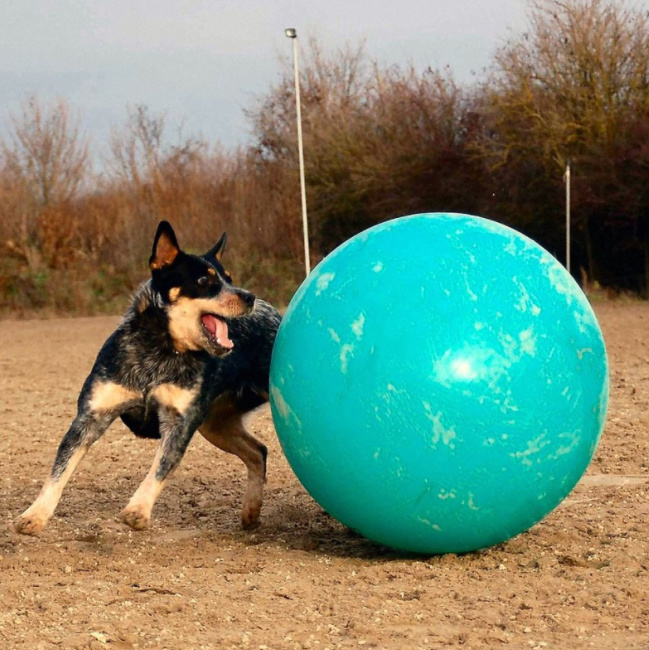
a. Tips for feeding Blue Heelers
i. Read the labels
First of all, remember to read labels. It isn’t safe to rely on hearsay or advertisements for nutritional information. Since the function of ads is to sell, they would exaggerate the food’s quality and downplay its deficiencies. Product labels, on the other hand, would list the ingredients. You can do a little research to find out which are safe for dogs.
ii. Don’t feed processed foods as a staple diet
Convenience dictates that the food we find on shelves is the best. However, the opposite is true.
Dog food that you find on shelves have no enzymes or nutritional value because of industrial cooking processes. Their nutrients are synthetic and therefore, unbalanced. They don’t offer enough to your pet in the long term.
iii. Feed whole pet foods
Unlike processed foods, whole foods have their nutrients intact. Include these in your dog’s diet. Here are some which are safe for your Blue. They are anti-inflammatory and will benefit it.
Yoghurt, especially Greek yoghurt, is safe for your pet. It contains proteins that help your Blue build muscle mass. Make sure that you choose yoghurt that has no preservatives. Lean proteins from pork, chicken, beef, and turkey will help your pet improve its constitution as well.
Pumpkins and carrots are a source of beta-carotene and vitamin A. They help manage your dog’s digestive system. Peas and greens are sources of potassium, vitamin C, and vitamin K. Rice and pasta are excellent sources of energy, while apples provide vitamins A and C.
Furthermore, whole foods like unbroken bones, carrots and Zucchini allow your pet to hone its teeth. It’s all about the chomping and sloughing action.
iv. Feed your Blue Heeler organic foods
It’s always wise to be aware of what your pet is eating. Genetically modified, non-organic food may cause health problems. Look for certified organic products. They may be expensive, but will significantly reduce your veterinarian’s bills.
Note that you should wash produce in apple cider vinegar as this would remove all pesticides. Also, some dogs may be allergic to wheat.
v. Give your Blue Heeler Omega-3 oils
Omega-3 prevents obesity and heart disease. It also gives your dog healthy skin and coat. Salmon, coconut oil, and tuna are rich sources of Omega-3.
vi. Don’t overfeed your Blue Heeler
Giving your pet too many treats leads to obesity. It’s easy to spot the dog that has eaten too many biscuits; it usually plump.
b. Choosing a dog food for Blue Heelers
When it comes to the right food for your Blue, you’d have to choose one for large breeds. These five choices are nutrient-packed and will give your pet an edge.
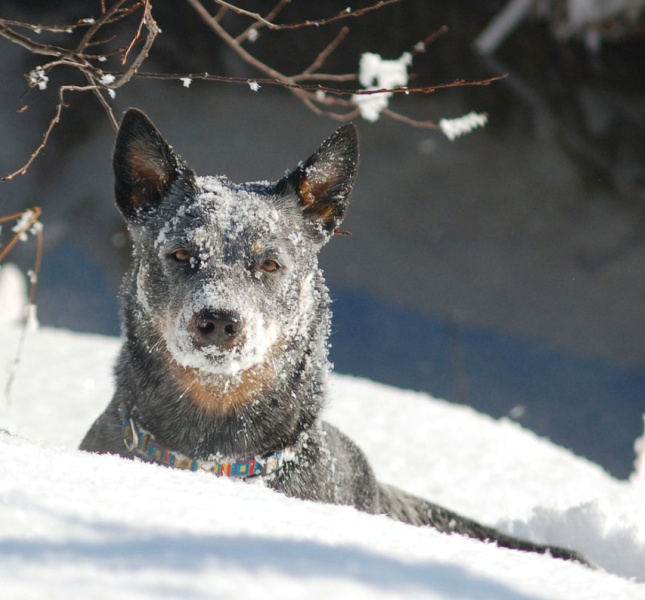
i. Hills Science Diet large breed dog food
The Hills company uses quality ingredients and believes in consistency. You can be sure that the food you give your dog will be top grade.
Furthermore, the company manufactures food in manufacturing facilities with the highest hygiene standards.
This food is well-balanced and has glucosamine, chondroitin, and calcium for joint development.
Of course, your Blue will find it delightfully scrumptious. Your pet is sure to clean its bowl.
Note that this food isn’t cheap. However, Hills doesn’t use artificial ingredients, preservatives, or colours. Also, the food is rich in antioxidants that protect your pet’s immune system.
Owners report that their dogs have lost little weight since being on this diet. They are full of energy, lean and mean. Others share that the food reduces shedding. The one disadvantage of this product is that some dogs may not adjust to it. You may have a problem with excess poop.
ii. Purina Pro Plan Performance
Your Blue is an active, working dog. Hence, it needs food morsels that give it energy. Purina Pro Plan Performance does just that.
Purina adds whole foods to its meal plans. Chicken is the prime ingredient in this food. With 30% protein and 20% fat, it feels your dog’s metabolic needs.
Since the blue is always up and about, it needs food that will nourish its muscles. Amino acids provide this nourishment.
Joint health is a concern since the Blue runs about so much. Purina has EPA and glucosamine support joint health.
Taste of the Wild gives large dogs like the Blue added energy. This product has Bison as it’s primary ingredient.
Finding a better superfood is hard. Taste of the Wild has all the vitamins and minerals that your pet needs. It is chock full of antioxidants, which benefits your Blue’s skin abandoned coat.
Taste of the Wild does not have artificial ingredients. The food contains whole grain, and there’s no colouring. It is safe for your pet. There is a steady source of microorganisms.
This family-owned company puts a premium on safety. What it makes is food in labs with the highest hygiene standards.
Many customers love Taste of the Wild because it contains quality ingredients. They say that it also helps their pets digestive health.
iv. Wellness Complete Health Senior
This food supports your dog’s well-being. It is a formula that helps your dog ‘s weight; deboned chicken helps with this.
It contains only natural ingredients; there’s no processed corn, soy, or wheat. There are no artificial colours or preservatives. Customers enjoyed that it ‘s natural and holistic.
v. Natural Balance Dry Dog Food
Natural Balance tries to minimise the artificial ingredients in its food. You won’t find colouring or preservatives. That helps digestion.
This food has duck as it’s primary ingredient, so you can be sure that your pet will get quality protein. Canola oil provides essential Omega-3 acids.
As its name suggests, it offers balanced nutrition for all stages of a dog’s life. Feed your small, adult or senior Blue.
This food is tasty, so your picky Blue will love it. Customers have said that it helps their pets’ digestion. Note that you will have to mix it with what your pet usually eats to help it adapt to the food.
10. Grooming the Blue Heeler
It’s not hard to get your Blue to look its best. This fellow has a short coat and is low maintenance. But you need the right tools. We show you how to groom your Blue and introduce you to a few must-haves for your grooming arsenal.
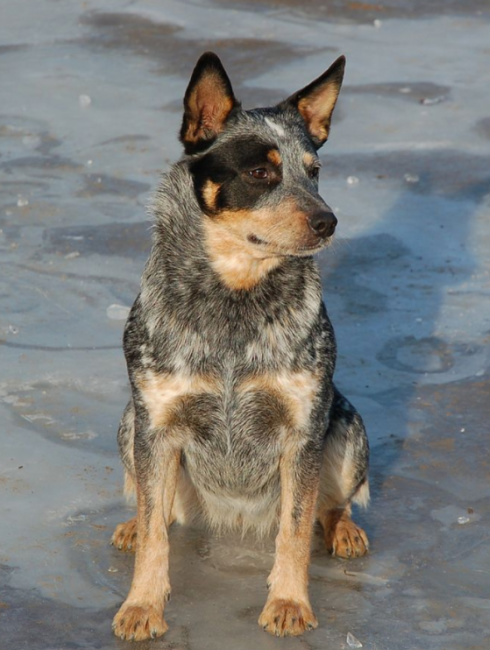
a. Grooming needs of Blue Heelers
This dog doesn’t take a lot of effort to groom. It sheds, but nor heavily. The dog’s coat will fall out during shedding seasons, so regular brushing is essential. It gets rid of dead hair and keeps it neat. How often you should bathe your pet depends on the climate and its lifestyle.
b. Brushing
As mentioned before, regular brushing is essential to remove loose or dead hair. A short haired dog like this usually needs weekly brushing at the very least. Doing so brings out the coat’s natural shine. Use a Slicker brush.
c. Bathing
Like every short-coated dog, your Blue Heeler may produce a distinct odour. Hence, you may have to bathe it frequently. Bathing not only removes offensive smells but also gets rid of loose and dead hair.
Use a spray hose or a pitcher to wet the dog. Take particular care not to let water drip into the eyes. Massage in your shampoo, working in the direction of hair growth. Towel dry the dog using a wrinkled, soft cloth.
d. Hair Clipping
The Blue Heeler needs only an occasional trim to remove excess hair. Use a pair of regular scissors to trim the areas around the paws, tail, and rear. Snip the hair around the belly as well.
e. Nail trimming
Nail trimming is stressful for dogs, especially if they had painful experiences. With careful cutting, it can be a painless and stress-free process.
Take your pet’s paw and massage it gently. Let it get used to your handling.
Then, proceed with the cutting. Use positive reinforcement. Never cut very long nails all at once. Do so a little at a time, and avoid the pinkish area called the quick. Cutting it would cause profuse bleeding. Nails get softer nearer to the quick. A good indication that you’re near it is just when you feel them softening.
f. Eyes and ears
The Blue may require some inspection around the eyes and ears to prevent infections from developing.
Dip a cotton ball in mineral oil or witch hazel. Wipe your dog’s ear, and take care not to affect the ear canal. Remove bushy hair growth with a small trimmer or tweezers. Use the trimmer to remove excess hair from the face.
g. Teeth
Dogs don’t often get cavities, but they do get gum disease because of tartar buildup. You should use toothpaste specially formulated for dogs because they are allergic to fluoride. Brushing your Blue’s teeth every day will reduce the need for you to bring it to the veterinarian for expensive scaling. Also, your pet will not have to go through the pain of surgery.
h. Grooming tools
Grooming your Blue is a breeze if you have the right tools. We introduce a few tried, tested, and enthusiastically affirmed ones to you.
i. PetTech Professional Dog Grooming Kit
This complete grooming kit has everything that you need. You can groom your pet as well as a professional.
One of the most common grouses about these kits is the noise they create. The PetTech kit is whisper-quiet. You won’t create a ruckus as you work on your pet’s hair. You’ll reduce stress on yourself and your dog. You probably know that dogs cannot tolerate loud noises because their hearing surpasses ours.
This kit is a breeze to handle because it has an ergonomic design. It’s easy to cut the hair around hard to reach areas. What makes it even easier is that it has Precision Blades that are adjustable.
PetTech is so confident of its product that it offers a lifetime guarantee. You can request a replacement if it is defective.
Customers report that the scissors are functional. The clipper is also lightweight, and their best quality is that they are extremely quiet. Dogs love it as much as their owners do.
This system is one of the quietest available. It is ideal for Blues which, well, become blue easily.
What do you get with BarkBath? You get the bathing tool, a handy sound dampening mat, a microfiber cloth for easy cleaning, and a bottle of fresh, no-rinse dog shampoo.
This system is portable; you can use it on the go. You can give your pet a bath even when you are on a road trip. It works as long as there is a power connection.
Functional nozzles allow it to work beneath the fur. They let the shampoo wash the skin clean. The soft-suction funnels dirt and water to a water tank.
This incredible tool conserves water. It uses only 48 oz of water, while conventional baths use up to 19 gallons.
Many users say that it cleans efficiently. It also dries, so you may not have to towel your dog off at all. The storage bag that it comes with makes it easy to put away.
The one issue you may have with his product is that the shampoo is rather harsh. You may substitute it with a softer, sweeter-smelling shampoo.
iii. The Furminator Deshedding Tool
Furminator has been a long-time player in the pet products industry and is renowned for its durable, reliable tools.
This deshedding tool consists of stainless steel, so it will not rust. It weaves through the dog’s top coat safely to remove loose hair. This incredible product will not cut through your pet’s skin. It will take care of your Blue’s shedding concern.
Owners comment that the tool works without creating piles of hair. The best part about this comb is that it works its magic without hurting your pet. Note that it may not work so well if your dog’s undercoat is exceptionally thick.
11. Fun Facts About Blue Heelers
The Australian Cattle Dog (ACD )is a lively, engaging fellow, and you won’t regret getting to know it. It’s a working breed, so people who prefer small, lap breeds may not understand it too well.
Not everyone likes to plough through sense pulled off information to find out what they want. Here is what you should understand about it in a fun nutshell.
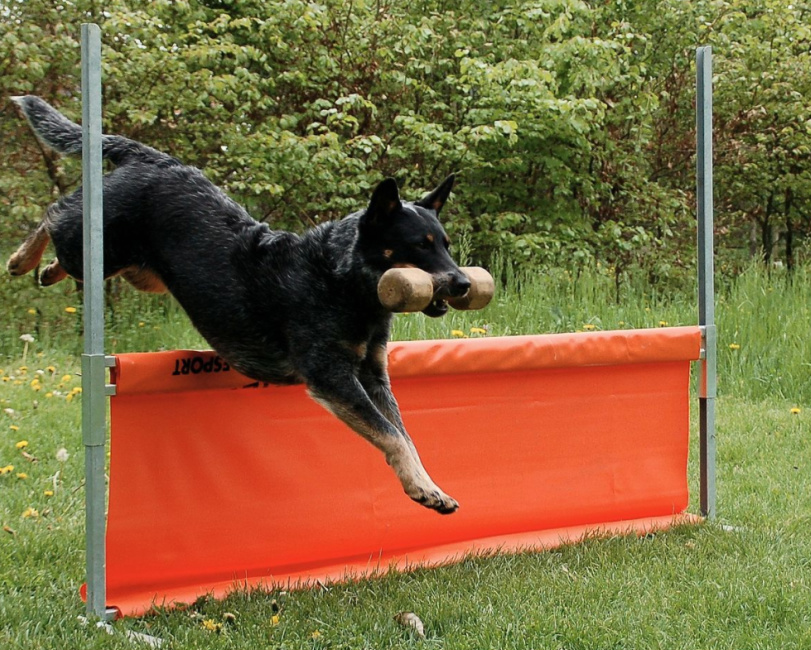
i. Blue Heelers are one of the world’s smartest dogs.
Like Border Collies and Poodles, Blues are renowned for their intelligence. Skidboot, mentioned in an earlier section, was unbelievably smart.
Their innate cleverness makes them easy to train for performance and agility events. Blues need both physical and mental stimulation.
ii. Blue Heelers need obedience training.
A Blue is strong-willed and somewhat restless, so it can get slightly edgy, especially if left to its own devices. Make sure that you teach your pet essential obedience commands like ‘sit’, ‘stay’, ‘come’, and ‘down’. Obedience training will redirect its intelligence and energy.
iii. Blue Heelers make excellent security guards
The Blue Heeler is loyal and protective. You can count on it to watch over you and your family. Its herding instincts prompt it to make itself the self-appointed guardian of its pack. Its defensive nature can make it a little snappish, so do supervise it when it’s around children.
iv. One Blue was the oldest dog in the world.
The Blue has a long lifespan, and one was the oldest dog in the world. Bluey, an ancient Australian Cattle Dog. was born in 1910 and herded sheep for two decades. He survived for another ten years until he finally succumbed to illness. His owners put him to sleep at the ripe old age of 29.
v. Blues are resilient.
A Blue named Sophie proved how hardy Heelers are. While on a boating holiday with her family in Queensland, Australia, a rogue wave hit their craft. The tenacious Sophie swam five miles back to shore on St. Bee’s island. She survived by hunting feral goats. A ranger found her and reunited her with her owners.
vi. Blues are excellent rodeo performers
Blues do well when put on a mechanical bull (please don’t let yours try this, of course). A Heeler named Hailey wowed crowds at the Ravalli county fair. It managed to stay atop a mechanical bull named Samson. Instead of using it to herd their cattle, her owners entrusted it with a more demanding job- entertaining people while riding a bull.
vii. Blues are adept at extreme sports.
At least one is, anyway. Hang gliding enthusiast Dan McManus, who has participated in the sport for over three decades, doesn’t do so alone. His trusty pet, an ACD named Shadow, accompanies him on his flying adventures.
Shadow is more than sporty. It is an intelligent psychiatric service dog which helped Dan with his separation anxiety. It worries about Dan’s safety, so it watches over him while he is in the air. Shadow flies in a harness and places a paw on Dan’s arm during the flight.
12. Breeding a Blue Heeler: Choosing the Right Breeder
So, you’re an ardent Blue Heeler fan. You may want to breed ACD puppies yourself or get a professional breeder to do it for you.
If you want to do it yourself, you must know how to get dogs to mate without risk of injury. If you wish to choose a Blue from an existing litter, it’s essential that you consult a professional breeder. So, how would you pick one?
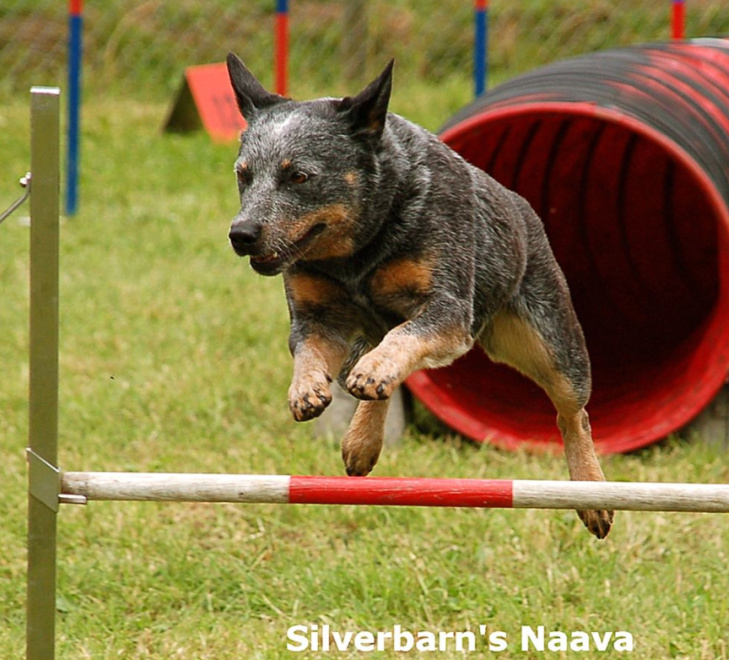
a. Responsible breeders breed dogs in the right circumstances
First, a tip. Never get your pets from puppy farms or mills. These places often breed lots of puppies to maximise their profits. Conditions in their breeding grounds are either cramped or unhygienic. Puppies who come from these mills may end up with minor or in many cases, severe injuries.
Responsible breeders will get their dogs to reproduce in hygienic, spacious conditions. They would have clean whelping supplies as well.
b. A reliable breeder will never let you take a dog home immediately
A responsible breeder will never sell a puppy to you without verifying if a Heeler is a good fit for your lifestyle. Remember how robust Blues are, so you cannot be too sedentary.
He or she will usually suggest a homestay and will monitor your progress with your new pet. You will have to return the pet to him or her if she feels that you are not a match.
The breeder will also encourage you to get your family members to meet the litter. You will be able t astatine if they can get along.
c. You will get to meet the parents
A reliable breeder will let you meet the pup’s parents. A litter may inherit genetic conditions or objectionable temperaments from them. You would be able to check the dogs for any hereditary disorders.
d. You will get to interact with the puppies
Reliable breeders will also let you observe the puppies. You will get to lift them to gauge how responsive they are to handling. The breeder will not have a problem with you watching how puppies behave in a litter. You can spot dominance or submission issues.
e. The breeder will know everything about the Blues (the dogs, not the music genre).
The breeder will be able to share everything about Australian Cattle Dogs and their needs. Furthermore, he or she will not breed other types of dogs. Exclusive breeding will show the person’s attention to detail and sense of commitment.
f. A responsible breeder may not always have puppies available
A breeder who is trustworthy may not always have a litter for sale. He or she will not breed puppies just for the money. If the person doesn’t have a ready litter, he or she will refer you to trusted sources which do.
g. A credible breeder we’ll meet the needs of the dogs
This person will meet the social, psychological, emotional, and physical needs of his or her Australian Cattle dogs. He o she will give them many opportunities for play, socialisation, and exercise.
13. Obedience training for Blue Heelers
When training a Blue Heeler, you must take into account its herding instinct. It also has enormous energy and stubbornness that you must channel positively.
Note that children should also be aware that Blues can be a handful and that it’s wise not to irritate them.
To train your dog well, you must understand it. Find out its requirements, such as when it needs to relieve itself. Confidence and assertiveness will make you an excellent dog trainer.
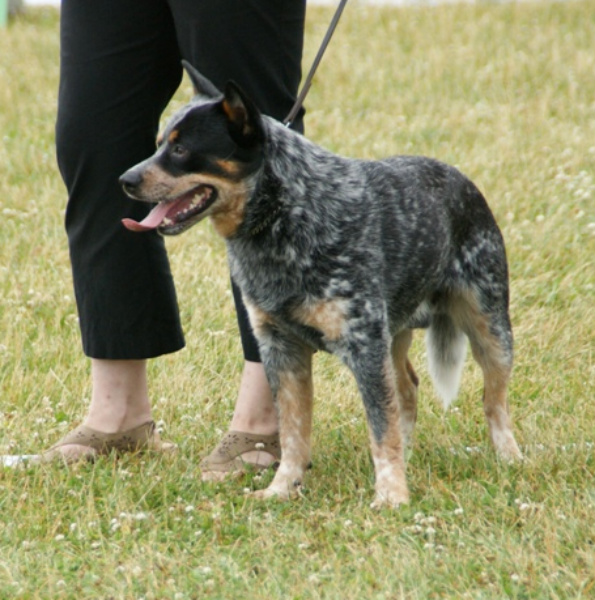
a. Teaching basic commands
i. ‘Sit.’
This instruction is the most basic, and one that all dogs must understand. It keeps your Blue in place if necessary.
Begin with a yummy treat in your hand. Hold it over your dog’s head. Its eyes should follow the goodie. As this happens, its butt should move towards the floor, putting it in a sitting position. At this point, say ‘sit’ and give it the treat.
ii. ‘ Come’
You will need to use this command if your Blue runs out onto the road. It can be a lifesaver.
Have a treat in your hand. Show it to your dog, and say ‘come’ in a happy voice. Reward your pet if it comes to you. Repeat this until your dog understands what the word entails.
iii.’ Stay.’
Your Blue will need to know how to stay put when you enter a store or are at a road crossing. Also, you won’t want it jumping on guests in your home.
Before your dog can learn to stay, it must learn to sit. Get your pet into a sitting position. Hold a treat in your hand. Raise it, and say ‘Stay’. Move back a few steps. Reward your pet with the goodie if it doesn’t follow you.
iv. ‘Down’
This command can be a little hard for your willful Blue to master because it involves some degree of submission.
Get to your dog to sit. Hold a treat under its nose and move down to the floor. Say ‘Down’ and get your dog to follow your movement. Once it is down on the floor, give it the treat.
v. ‘Heel.’
The ‘heel’ command gets your pet to walk in step with you. Put your dog on a leash. The lead should be across your body.
Use the ‘heel’ instruction if your pet begins to tug at the leash. Turn a 90° angle and block your dog’s way. Say ‘heel’ and steer it where you want it to go. When it does, give it a treat.
vi. ‘ Roll Over.’
This trick is fun and will get your Blue to bond with you. It will also entertain friends and family members.
To begin, get your pet into a ‘down’ position. Kneel beside it and hold a yummy treat under its nose. Move your hand from the nose to its shoulder. This movement would get it to roll on its side with its head on the floor.
Continue moving your hand until it lies on its back and onto the other side. Use the phrase ‘roll over’. Reduce your hand movement when you notice your dog beginning to understand what you require.
b. Dog training tools
Training your Blue Heeler is a breeze if you have the right tools. Here are few safe ones that will make learning a joy for your pet.
The Shake Trainer is a straightforward, yet effective way to train your Blue and stop behavioural problems. Use it to prevent chewing, chasing, digging, and other annoyances.
What does this incredible tool do? It emits a consistent sound frequency when you shake it. It’s enough to stop a Blue Heeler’s irritating behaviour.
This device gets your pet to stop doing what it isn’t supposed to in less than 7 minutes. You don’t need any other tool, which allows you to save money.
Dog training professionals and veterinarians endorse this product. It’s humane and will not emit ultrasonic frequencies. It is not like a shock collar which stuns pets and causes them pain.
According to satisfied customers, this tool has an immediate effect. An owner of a Cairn Terrier reported that it stopped her dogs excessive growling. One grouse about it is that it’s a little bit big.
ii. One Tigris Tactical Dog Harness
This tactical vest is a useful one to have during training sessions.
It comes with various pouches where you can store your Blue’s favourite treats. It comes with handy water bottle holders as well.
The vest comes with webbing that you can adjust so that it fits your pet comfortably. It stays in place even as your pet runs around.
One feature of this vest is the unique, stylish patch furniture. The mesh provides better ventilation for your feisty Blue.
Users found it lightweight and snug. It makes an excellent travel vest for your pet. The best part about it is that you can customise it to your pet’s needs. Most dogs have found it so comfortable that they refuse to have it removed.
iii. Puller Plus dog toy rings
This set of rings is more than just a toy; it’s a full-fledged fitness tool. It gives your Heeler a full workout.
This training tool is ideal for getting your pet to fetch. It’s so comfortable to chew on that your pet will be excited to bring it back to you.
This toy is ideal is your pet enjoys playing frisbee. You and your dog will have hours of fun playing catch.
It consists of non-toxic material, so don’t worry when your pet carries it in its mouth. According to customers, it doesn’t smell. Many of them also say that it’s light, and easy for their pets to handle.
Do remember to supervise play. Random use may lead to accidents or to choking. Also, watch out for mishandling. Your children or pet may destroy it if they are too rough.
14. Dealing with your Blue Heeler’s annoying Behavior
Your Blue is prone to undesirable behaviour like any other dog. This adorable but sometimes temperamental fellow can be a task to manage. Here’s what it may do, and how you can keep it in check.
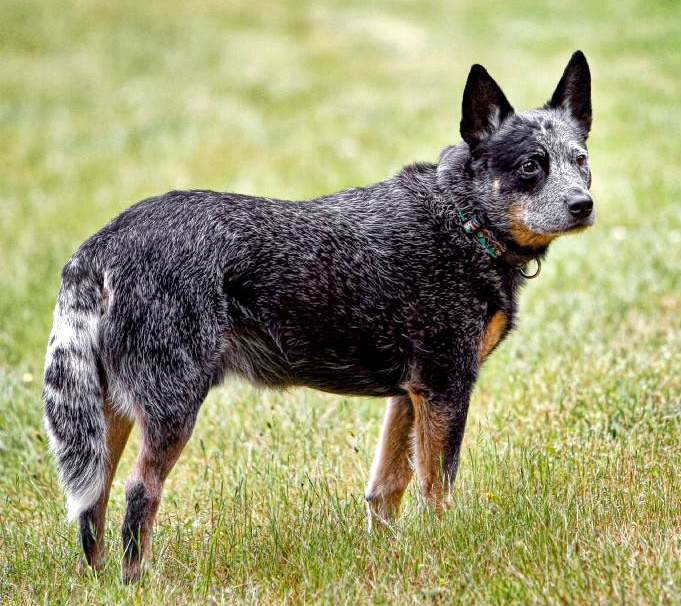
a. Barking
First of all, your Blue is a herding dog bred to control livestock. Don’t be surprised if it does its work by barking.
Well-intentioned as it is, it must learn when to stop. Do this by using the phrase ‘no speak’. Close its muzzle gently and say it at the same time. Your Blue will learn not to ‘talk’ when you give the word.
b. Chewing
Chewing is an irritating behaviour that’s in every dog’s genes. A Blue needs lots of stimulation, so it may succumb to the temptation to sink its teeth into something if it doesn’t get any physical activity.
When you spot your pet with your shoe in your mouth, take it away and replace it with a chew toy.
c. Chasing
Of course, a Blue love the chase. After all, its primary function is to go after livestock. So how do you stop it from treating every car that drives by like lost cattle?
Start by leashing it before you head outdoors. Also, teach it to respond to the sit, stay, and come commands. Keep it on a leash whenever you go out as well. Give it chances to chase other dogs at dog runs all parks.
d. Nipping
The Blue is Infamous for its nipping behaviour. It developed this habit because of its herding style – it nips the heels of livestock to keep them moving.
That said, it must know that nipping causes pain. Yelp whenever it mouths you. This fellow is loyal and cares for its owner, so it will stop if it knows that you don’t condone its behaviour.
e. Digging
Again, your Blue may resort to this if you leave it alone for too long. Remember that it needs lots of space.
Keep it in a part of your yard where you don’t mind the mess and let it dig in that area. You may not be able to eradicate Its digging tendencies, but you can keep them in check.
f. Begging
Dogs beg because our food is tasty. The habit is somewhat embarrassing. So how do you stop it?
Ignore the behaviour. Even saying ‘no’ gives it undue attention. Your dog will learn that it doesn’t always get what it wants.
g. Gulping
Some dogs gulp their food because they are afraid that other pack members may get to it first. This behaviour is dangerous because it may lead to choking.
So, how do you stop your dog from swallowing its food too fast? Use bowls specially designed for getting pets to eat less.
h. Aggression
Blues are a little dominant by nature. Though this hardly happens, it may become aggressive under stress.
Socialisation is crucial. Let it interact with other pets and people. Remove it from potential conflict situations.
i. Separation Anxiety
Separation anxiety is never straightforward for a dog which loves its owner, and a faithful Blue may find it trying. Not being around its owner may turn it destructive.
Play soft music before you leave your home. The music eases your stress. Your dog will know that you have its welfare in mind.
15. Blue Heeler Health
Australian Cattle Dogs are typically physically fit, but they may develop health conditions as they age. Here are some of these illnesses and their recommended treatments.
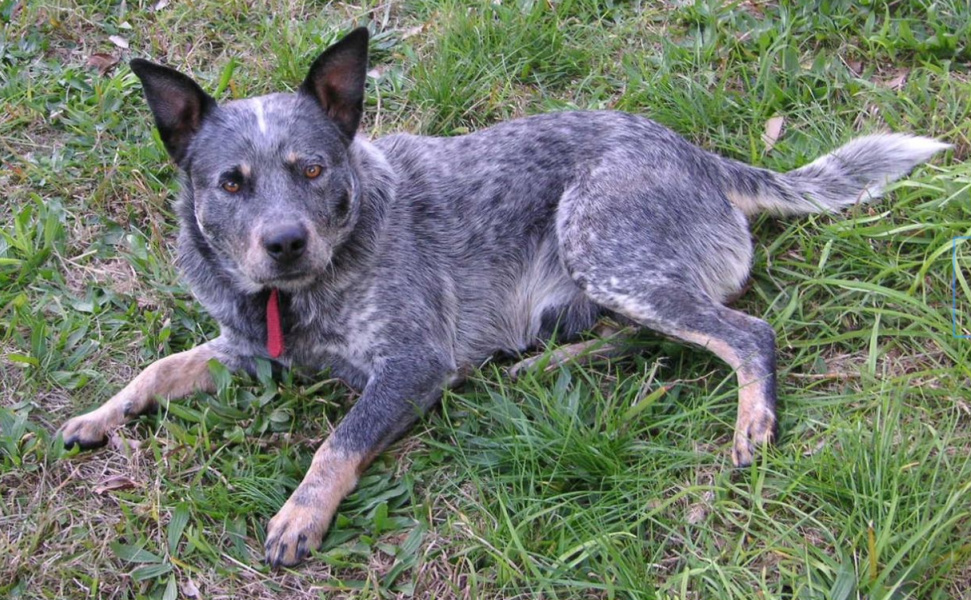
a. Progressive Retinal Atrophy
Progressive Retinal Atrophy (PRA) often happens in Blue Heelers. The retina gradually deteriorates, causing a loss of vision.
If your Blue suffers from this, you’ll notice it having difficulty seeing at night. Its pupils may widen, and it will bump into furniture all the time. It may also find it difficult to navigate stairs. Their eyes will become cloudy as well. Owners should consult their vets for the proper management of the condition.
b. Canine Hip Dysplasia
Hip dysplasia is the dislocation or degeneration of the femur or the hip joint. It becomes loose, causing difficulty walking.
Doctors will recommend that your pet exercises regularly. Physical therapy may increase its mobility as well. Joint prescription diets may improve the healing of its cartilage.
Medication like NSAIDs (non-inflammatory drugs), may reduce the pain. Acupuncture, or the ancient Chinese remedy of tapping on the body’s Qi (energy), may help as well. You can help your pet by creating ramps.
If the condition is severe, the vet may recommend total hip replacement. If you have a Blue puppy with hip dysplasia, your vet may suggest Juvenile Pubic Symphsiodesis, which involves neutering.
c. Deafness
Blue Heelers are prone to deafness. Some can’t hear at all, while others may do so to some extent.
There are a few ways to tell if your Blue is deaf. If it doesn’t seem to respond to you when you approach, it may have difficulty hearing. Other signs of deafness are excessive barking and an unusual lack of reaction to noise. Its ears will not tremble when it hears loud noises.
d. Other issues
Blues may develop blood vessel irregularity because of liver shunts and cataracts. The symptoms of these diseases aren’t always visible, so, regular appointments with your vet are a must.
16. Travelling with your Blue Heeler
Dogs make excellent companions, so it’s not surprising that you’d like them with you wherever you go. If you love having your Blue with you on the road, here’s how you can guarantee a safe, pleasant journey for both of you.

a. Vaccination records
First, make sure that your dog has its vaccination papers. It may need them in the event of an emergency. You will also need them when you are boarding your pet. You won’t want a customs officer to deny you entry into a country because your pet hasn’t got updated vaccinations records.
b. Have a collar and a leash
Have your pet’s collar and leash with you at all times. You should have poop bags with you as well. Remember that new places come with new smells, so the leash will keep your dog in check if it’s too enthusiastic.
c. Tags
You won’t want your Blue to get lost. Attach tags to its collar. Use your cell phone number as a dog tag number.
d. First aid kit
Prepare a doggy first aid kit for your Blue, just as you would for yourself and your family. If there aren’t any available at the pet store, put your own together. You should include tweezers for tick removal, styptic powder to remove bleeding, eye wash, ear wash, antiseptic wipes, adhesive tape, and gauze.
e. Food and water
Remember that you will go to places where water isn’t as accessible as you’d like it to be. Make sure that you have some with you in case your pet gets thirsty. Have its favourite food with you as well.
f. Seat covers
You don’t want your pet to walk all over your car seat with its muddy paws. Have wipes to clean up your pet as well.
g. Safety restraints
Install seat belts for your pet in your vehicle. You don’t want your Blue to turn into a living projectile. It may find them uncomfortable, but they will keep it safely in its seat.
h. Crate and dog bed
Little Blue will need its bed and blanket. If its crate is also its sleeping area, make sure that you have it with you as well. Like you, it will need a good night sleep.
i. Fun items
Your Blue will feel a little nervous on vacation, and that’s normal. Soothe its nerves by bringing its toys with you. If your dog is a music lover, pack its favourite CD.
j. Hotel reservations
You are ready to go. Before you leave, make sure that the hotel you’ve booked is expecting your pet. Of course, you should have made sure that it is pet-friendly.
k. Air travel with your Blue
Flying with your pet can be stressful, but it needn’t be a nightmare. Make some preparations before flying with your pet.
Research your options, because not all airlines have the same travel policies. Some may be pet-friendly, while others aren’t.
Also, prepare your Blue for the flight in advance. Make sure that you crate train it because it may be apart from you during the journey. Desensitise it to noise and crowds.
Make sure that your pet has enough food and water. You don’t want your pet to suffer from dehydration, but you’ll want to restrict its water intake lest it needs to go on the plane. Give it a potty break before you leave.
16. Games to Play With Your Blue Heeler
The Blue Heeler is physically energetic and mentally active. This brawny and brainy fellow needs physical and mental stimulation. Keeping it occupied is challenging, but can be fun. Here are a few games that will keep it on its paws (toes).
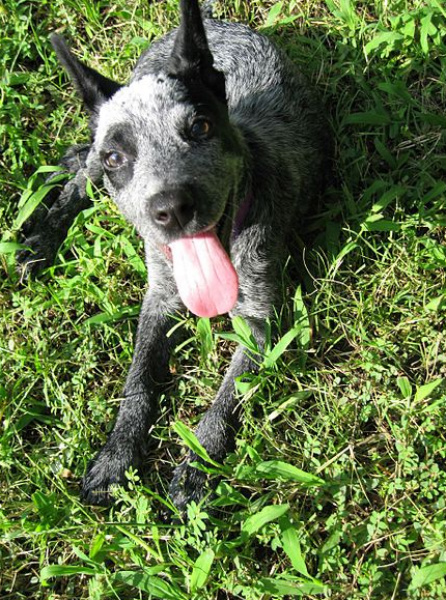
a. Hide and Seek
First of all is a game that you’d know at the tips of your fingers, Hide and Seek. It’s as fun for your pet as it is for little children.
To play it, you can tell your dog to stay while you hide somewhere. Alternatively, you could get someone to bring it to another room.
Once you are ready, say ‘Come find’ or “Go find’. Your dog will use its powerful sense of hearing to seek you out.
b. Treasure Hunt
This game is another version of ‘Hide and Seek’, but you use treats instead of well, yourself. Place treats all over your home and has someone hold your pet in another.
Once ready, call your pet and say ‘find’. Have fun watching your pet look for the treasures.
c. The Cup Game
If you have a mind to set up a pet casino, include this game. You’ve probably seen it played by little kids on the street.
Place three cups in front of your pet. Take a treat and put it under one of them. Move the cups around until your dog manages to find the goodie.
d. Red Light Green Light
This game is excellent to play with a Blue, which can get a little excitable. It’s also a great way to teach obedience commands.
It’s simple. Replace ‘stay’ with ‘red light’, and ‘come’ with ‘green light’.
e. The Name Game
Your pet may already recognise words like ‘ball’ and ‘treat’. It’s an excellent way to teach your pet to fetch and to expand its vocabulary as well. Give it the name of an object and watch him look for it.
f. Pick Up
This game is a variation of the one above. It gets your pet to pick up after itself and become a help around the home.
Once your pet picks up an item, get it to put the object in the desired location. Then, teach it words like ‘drop it’.
g. New Trick
This game gets your pet to learn new commands. You can use ‘new trick’ to replace words like ‘roll over’.
Get your pet to do whatever will impress you. It could be to sit, stay, or even come. The idea is not to repeat its actions. Give it a treat after each trick.
h. Treat toys
There are many variations of the Kong available. Get one for your pet. It will have hours of fun trying to get the treat out of the toy.
i. The Muffin Tin
This game will give your Blue a mental challenge. Put a few treats in a muffin tin and cover it with balls. Then, watch as your pet tries to remove them to retrieve the goodies within.
j. Puzzles
Dog puzzle games will get your Blue’s mind working for hours. Many puzzles get dogs to flip lids, open drawers and even turn doorknobs. These improve its confidence and stave boredom. They also represent opportunities to bond.
k. Tug of War
This game is a little controversial – non-advocates say that it promotes aggression. The key is to play it correctly.
Play tug with an old shirt or another item, as you usually would. When your Blue becomes too enthusiastic, say ‘leave it’ or ‘drop it’. It doesn’t accelerate dominance; instead, it gets your pet to understand that you’re fun to be around.
l. Which Hand
This game is the perfect starter for pets. It works well with dogs that haven’t done nose work before.
Stretch your hands towards your dog and have it guess which one contains a treat. Switch the goodie quickly between both of them. Reward it when it identifies the correct hand.
m. Free Shaping
This game works on the premise of small steps and your Blue’s natural willingness to learn.
Use a prop such as a box of treats. First, get your pet to touch it without giving signals. Praise it each time it does so, or reward it with one of the goodies. Build by getting your pet to put its foot in the box.
n. Make your pet work for its food
Your Blue loves work, so let it earn its food. This activity is mentally stimulating. Get your pet to perform tricks just before its dinner. You may also feed it from a treat dispenser.
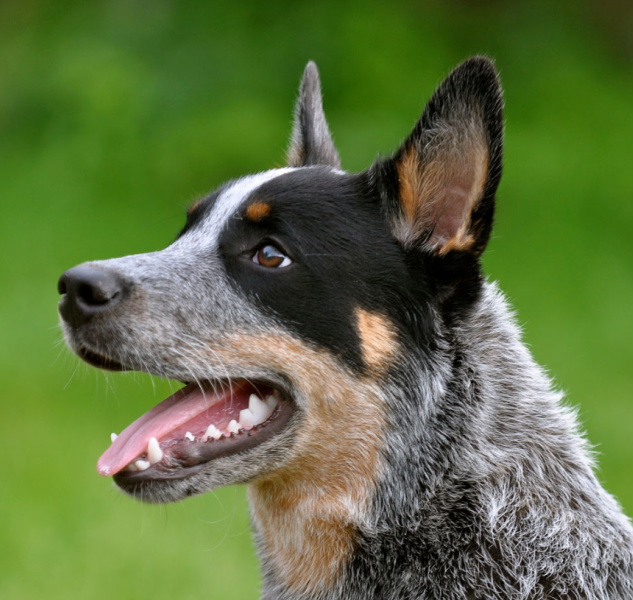
o. Doggie Massage
A massage relieves stress for both dog and owner. Its excellent for pets which have arthritis, as it soothes aching joints. It also creates a bond between you and your pet.
p.Tag
You will need a partner for this game. Each of you should sit on opposite sides of the room.
Take turns calling your dog and rewarding it with treats each time it obeys. This game reinforces the ‘come’ command.
q. Create an obstacle course
Do you have a lot of junk at home that you want to use in some way? Take them and create a mini obstacle course for your pet.
You could get your pet to jump over towels or through hula hoops if you have them. You could even get your pet to climb over a mini step-ladder. It will keep your pet mentally stimulated and focused.
r. Bubbles
Do you remember how much you enjoyed blowing bubbles and chasing them in your garden? Your pet will have fun doing the same.
Dogs are particularly fascinated by bubbles. There are selections of bubble toys at pet stores. You and your pet will have loads of fun.
s. Play Date
This activity gets your Blue to socialise. Find it a play date. You can meet ‘friends’ at dog runs or during walks. Invite the dog to your home and watch the pets have lots of fun.
t. Grab The Leash
This trick is an excellent way to get your pet to understand that it’s time for its walk. Get it to grab its leash when its time to go outside.
In conclusion, the Blue Heeler is one of the most robust and intelligent dogs around. It will become a companion for life if you feed it well, take pains to housebreak it, give it obedience training and groom it. You will be able to get it to work for you and bring it on road trips.
